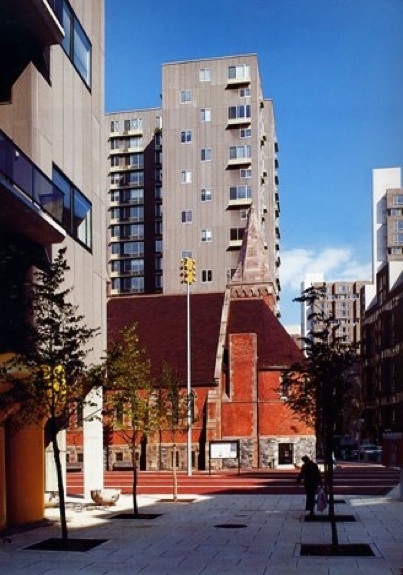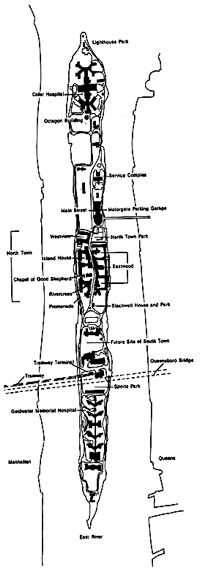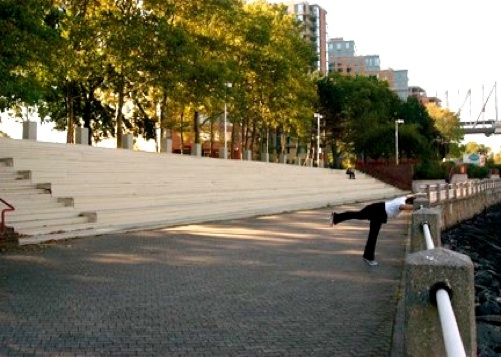ROOSEVELT ISLAND HOUSING, NEW YORK



























Website Copyright © 2011 John M Johansen All Rights Reserved
No information, photos, videos or audio on this website may be distributed, copied
or otherwise used without the written permission of John M Johansen or his representative
Website created by John Veltri and Marguerite Lorimer EarthAlive Communications www.earthalive.com
Please direct inquires to info@earthalive.com


Roosevelt Island, located on the East River astride New York City, was a unique 'Social and architectural experiment. Accommodating low income/highly subsidized, middle income/limited subsidy, and high income/ conventionally financed tenants, it represented great financial diversity as well as a mix of race, culture, and mores. Its master plan provided a unity of architectural expression through guidelines, yet variation of interpretation by selected architects. It proved to be a "peaceable neighborhood" of balanced public service, fine schools, and amenities unusual in urban life.
Naturally, Ashok Bhavnani and I were pleased to be asked by Ed Logue, director of the New York State Development Corporation, to be part of the design team which also included Conklin Rossant, Aldo Giurgola, SertJackson, and myself.
The urban plan by Philip Johnson proposed an angled central street with buildings as fingers reaching and stepping down toward both banks of the river. As his proposal did not deal with a realistic density, it was not literally a master plan, and the team's studies resulted in building heights not 10 stories, as he intended, but 18 stories. Johnson was insulted and said, "That is no longer my Island."
At first we were encouraged to be highly innovative in our design and use of building technology. Later, as the corporation became fearful of construction costs and anticipated market resistance to anything other than conventional housing, we were advised to modify our designs. Rossant and Giurgola refused and they were fired. Sert and I somehow held course and, as good friends, coordinated our separate designs rather well. Later, with Adam Yarmolinski as director, we were advised that, for security reasons, courtyards of the upper income apartments must be barricaded against the potentially threatening lower income people across the street. As this contradicted Ed Logue's central idea of an open neighborhood, I resigned as architect until this directive was finally withdrawn.
My commissions were Island House apartments for middle income tenants, and Rivercross, a luxury cooperative. In addition we designed two schools, a day care center, two swimming pools, commercial space along Main Street, and design of the central plaza of the Church of the Good Shepherd. This entire commission was the largest I had been granted, and though it allowed me less latitude in which to express myself, its organization was received quite favorably. Paul Goldberger wrote in the New York Times: “There is a well-planned two-bedroom apartment at the end of Island House with a bedroom that feels as if it were jutting out over the water, and has views up and down the river that makes it one of the most spectacular medium-sized apartments built in New York in years...” - John M Johansen






















Aspects of the design with which I was most pleased included the openings at the base of each building near their elevator lobbies, allowing a confluence of the path systems to continue through each building, also providing a common terrace where people could meet, bask in the sun, and feel sheltered. My original idea of the “front stoop” was carried out here.
In the AIA Journal, the critic Steven Krog made these observations:
These entrances are an organizing force of significant dimension. In addition to their obvious function of ordering people’s movement, they delineate principal spaces adjoining the buildings and coincidentally influence their use. The pleasing variety of sequential space experiences available to anyone strolling in North Town is largely the product of the placement of these convergent points and the strategic employment of grade changes. In many instances, the act of leaving a building extends onto the adjoining plaza or sidewalk rather than concluding with the closing of the door.
My concern for the social life of tenants was also expressed in the duplex apartments, where every other floor landing provides a communal space which neighbors may use for recreation, social events, or children’s play. The uppermost apartments were reached through fully glazed bridges leading from elevator landings. A singular construction feature of these









buildings was the formation of the exterior wall. A three-inch thick, cellular extruded cement-asbestos panel called Corespan was first used here. Requiring no scaffolding, as brick does, panels were aligned by laser beam from the ground and clipped onto the slab edge, resulting in a substantial saving in cost and time over conventional brick.
- John M Johansen
Interesting facts ABOUT ROOSEVELT ISLAND (Wikipedia):
-
• The Lenape (aboriginal natives of the island, who were sometimes later known as the Deleware) called the island Minnehanonck
-
• Considered a part of Manhattan, the island is two miles long, with a maximum width of 800 feet and a total area of 147 acres.
-
• In 1832 Hellgate House of Reform was constructed on the Island
-
• In 1839 the Island opened its notorious New York City Lunatic Asylum, which at one point held 1700 inmates, twice its designed capacity
-
• In 1852 a Workhouse was built on the island, designed to hold petty violators in its 220 cells
-
• The Queensboro Bridge, which passes over the island but does not provide direct vehicular access to it, opened in 1909
-
• Welfare Penitentiary, which once held entertainer Mae West - and Nazi spy Fritz Joubert Duquesne, leader of the Duquesne Spy Ring - closed in 1935
-
• Known as Blackwell's Island, then Welfare island (1921-1971), the island was officially renamed Roosevelt Island in honor of Franklin D. Roosevelt in 1971
-
• Former United Nations Secretary-General Kofi Annan was once a resident of Roosevelt Island